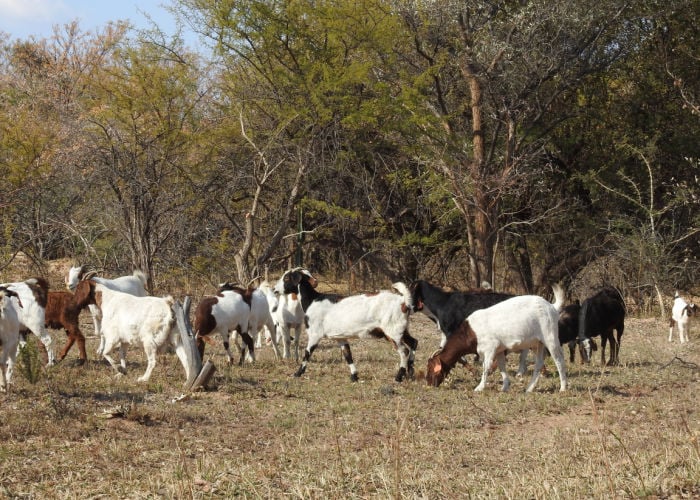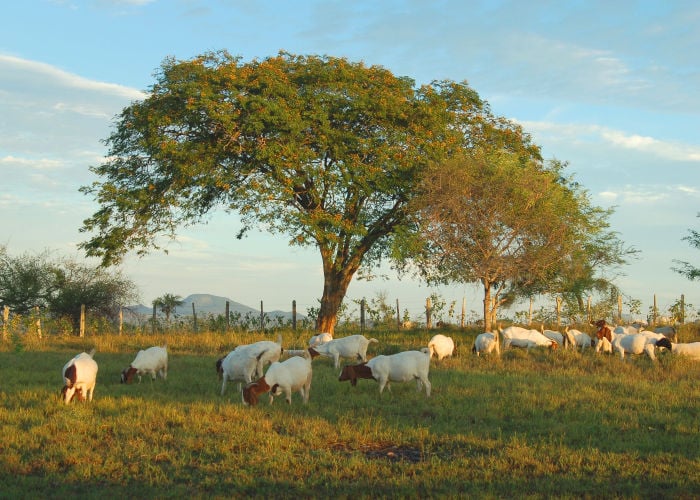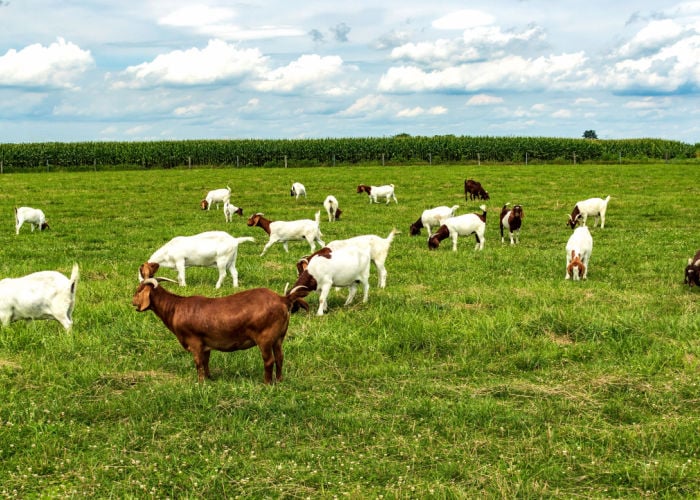Goats are an increasingly popular choice for farmers and ranchers due to their hardy nature, low maintenance needs, and versatile uses.
One of the most popular types of goats is the rangeland goat, known for its versatility in adapting to a number of different climates and terrains.
For those looking to raise goats as livestock or just as a hobby, the rangeland goat may be the perfect choice.
Let’s take a closer look at why!
What is the Rangeland Goat?
Rangeland goats are indigenous to Australia’s rangelands, and their hardiness has made them an invaluable source of goat meat for the processing industry.
It is estimated that nearly 90% of all goat meat comes from these goats, providing an essential protein source for many communities.
Unfortunately, a lack of human interaction or intervention means that the individual health status of each animal is often unknown.
This means that producers need to be extra vigilant when selecting wild goats to avoid introducing unwanted parasites, diseases, or weed seeds into their herd.
However, despite this, rangeland goats are undoubtedly an integral part of the unique rural culture of Australia and continue to play an important role in the country’s food production.
History of Rangeland Goats
The Rangeland Goat is an incredibly unique breed of goat hailing from the great land down under—Australia.
This particular breed was developed to provide a cost-efficient source of meat without killing too many cattle, and they have proven their worth!
Such goats make up 90% of Australian goat meat production, making them a true signpost of the continent’s culinary tradition.
Not only do they produce excellent meat, but also a liter of milk per day on average!
It goes without saying that this breed is quite proud to be Australian—having been bred from many different varieties ranging from Nubian to Boer or Kiko.
Its success has meant that now, its legacy lives on throughout many regions in Australia and beyond!

Rangeland Goats Characteristics
Rangeland goats are capable creatures that have a variety of desirable characteristics.
They are tough and able to survive in dry climates; as a result, they are well-suited for the goat meat trade and live trade since their production can be kept high even when water is scarce.
Their maintenance costs tend to be quite low since these animals do not require shearing, crunching, or mulesing when compared to other breeds.
Even more impressively, crossing the Rangeland goats with other breeds can bring about hybrid vigor. For example, breeders often cross them with Boer goats.
Beyond their useful traits, Rangeland goats are visually stunning animals with short hair on their tall and broad bodies.
Their heads come complete with two medium-sized hanging ears and horns that are slightly smaller than those of other breeds.
They tend to come in colors such as black, brown, or white, but some have combinations of different colors as well.
What Do Rangeland Goats Eat?
Rangeland goats are great browsers, able to find most of the nutrients they need from whatever vegetation is available in their habitat.
However, if you raise them in confined conditions, changes to their diet should be phased in gradually and supplemented with a fibrous or roughage component.
Whatever their living space, Rangeland goats are incredible eaters, happily munching away on a variety of tough vegetation when in the wild.
This includes shrubs, small leaves, and even some of the tougher grasses that normally wouldn’t be touched by other animals.
In fact, they often consume things other animals ignore, such as thistles and weed stems, because of their extremely hardy digestive system.
Again, when kept in a domesticated setting, it is important to introduce dietary changes gradually so the goats can adjust properly before switching to hay pellets or other high-fiber feed components.
Adequate provision of clean, fresh water is also important. The amount of water consumed can differ depending on weather conditions, the state of the goat, and the type of feed.
Make sure that your goats have easy access to an unlimited supply of water to stay healthy and happy.
RELATED: What To Feed Goats: Goat Feeding Diet on a Farm, In the Wild and During Winter
Breeding Rangeland Goats
Breeding rangeland goats can be beneficial for any producer. The breed is especially able to sustain the high fertility rate in dry conditions, making them a great choice for harsh environments.
Cross-breeding with other goats, such as the Boer goat, can lead to hybrid vigor and a better-performing overall animal.
Although full cycle reproduction may vary between goat breeds, an average doe should reach between two and three kids per year without assistance, depending on desired yield and breed-specific requirements.

The Difference Between a Boer Goat and Rangeland Goat?
A common question has to do with the difference between Boer goats and rangeland goats. To be fair, the two look similar, especially since some rangeland goats have Boer goat genetics.
Boer goats are a hybrid breed made by combining native African goats with British, Indian, and other European breeds developed for meat production.
Rangeland goats, however, add some uniquely specific characteristics to the mix—namely, their superior adaptability to rangelands.
This means that rangeland goats can more easily survive in semi-arid climates and thrive on sparse vegetation with minimal care and attention from their owners.
As such, they are an ideal choice for herders or farmers whose properties or acreages are large, dry, and rugged.
This allows them to keep as many goats as they wish while dedicating a small amount of time to their husbandry and upkeep.
Benefits of Raising Rangeland Goats
Let’s take a look at some of the benefits of raising rangeland goats.
Hardiness
Because of their remarkable hardiness, Rangeland goats offer many advantages for farmers.
Not only are these animals incredibly resilient in terms of surviving a wide range of climates, but they also do fantastically well in hot and dry environments where there may be less rainfall.
This makes raising goats easier than other livestock since farmers don’t have to worry as much about the animals struggling in harsher conditions.
Rangeland goats need little nutrition to stay healthy, and they can adapt quickly to sudden changes like shifting weather patterns or moving locations.
The combination of these characteristics adds up to an excellent choice when it comes to selecting livestock with ease and longevity.
Inexpensive to Start With
Raising rangeland goats provides a great opportunity for farmers looking for an inexpensive and sustainable way to raise livestock.
Goats require low input and are often quite easy to find in many parts of the country.
With careful management, it’s possible to bring them onto previously unmaintained land and create viable grazing pastures. The cost of getting started with a herd is relatively low too.
Many farmers have found success simply mustering up a few goats, fencing them in, and finding the resources they need to start this venture.
Nutritious Meat
Rangeland goats can provide a source of nutritious meat that is low in fat and cholesterol. They are excellent sources of protein, iron, zinc, vitamin B12, and niacin.
In addition, their meat has a mild flavor that makes it suitable for many recipes and dishes. This makes it popular among consumers who prefer leaner meats.
High Reproduction Rate
Rangeland goats are known for their high reproduction rate, which makes them ideal for farmers who want to increase their herd quickly.
Female goats typically become sexually mature at around six months old and can reproduce every nine months after that.
Female goats can produce up to three kids per year! This allows herbs to grow quickly without having to purchase additional animals from other farms or breeders.
Not Prone to Many Diseases
Raising rangeland goats can be a profitable business venture due to their low maintenance needs.
They don’t tend to face the same diseases as other livestock because they are not prone to common issues like fly strikes and skin cancer.
In addition, they do not require shearing and take on minimal costs for things like tagging and providing food and water.
This is also beneficial for farmers since goats can survive by eating a gentler variety of feed than other livestock.
Eat Just About Anything
Goats can actually benefit the environment since they tend to graze on plants that would otherwise become overgrown, clearing land while also providing food.
One of the biggest advantages of owning goats is their ability to eat just about anything.
This means that the cost of paying for feed is quite low compared to other animals.
Additionally, their flexible diets allow them to thrive in many different climates without increasing the economic burden on their owner.
No Shearing, Crutching, or Mulesing Required
Shearing involves cutting the wool off of the animals in springtime. Crutching and mulesing are procedures created to rid the sheep of pests and reduce fly-strike risks in their dirty wool coats.
By avoiding these procedures altogether, goat farmers are able to keep their costs low and profit high compared to other livestock ventures.
Great Souce of Meat
Rangeland goats produce leaner and healthier meat than other breeds of goats. They are ideal for consumers looking to lower fat consumption while still eating delicious, high-quality fresh and frozen meats.
Furthermore, these animals have a fast growth rate and begin maturing much younger than other types of meat goats.
This allows producers to reap the benefits of their labor quickly and efficiently, with a short turnaround time between market readiness and sale.

Challenges When Raising Rangeland Goats
Rangeland goats are a popular choice for many farmers, as they offer a number of benefits, such as providing high-quality milk, wool, and meat.
However, there are also numerous challenges associated with raising goats on rangelands. This section will take a look at some of the most common issues that goat farmers face.
Tendency to Damage Fences and a Need for Sturdy Fences
Raising rangeland goats comes with a unique set of challenges, chief amongst them being the tendency of goats to damage fences.
In order to effectively contain the animals, it is essential that fences are sturdy and built to be tall enough to deter enthusiastic climbing.
For the average four-wire fence, this simply won’t suffice, so producers need to look towards adding in extra features, such as a line of barbed wire at the bottom for added reinforcement.
Nevertheless, it’s not always feasible or practical to build large, complex fences from the outset.
Most rangeland goat producers start small by creating a paddock close to their yards and then gradually begin expanding outwards.
Issues With Overgrazing
Goats have a tendency to overgraze certain areas of land if not managed properly.
Overgrazing can lead to soil erosion, which can damage the land and make it difficult for future generations of farmers to use the land effectively.
To avoid this problem, it is important to practice rotational grazing so that each piece of land has time to rest and recover before being used again by the goats.
Where and How to Buy Rangeland Goats
If you’re looking to add some goats to your rangeland, purchasing them is a process that requires thought and caution.
When deciding on where to buy them, it’s important to do your research and find the most reputable sources.
Doing so will ensure you’re getting the highest quality animals at the best prices.
As far as price goes, range goats can cost anywhere from $200 to $500 depending on the breed, sex, and age of the animal.
To ensure you get the lowest possible prices that fit within your budget, shop around for different deals and look for sales or discounts if available.
Lifespan of Rangeland Goats
Rangeland goats have the potential to live up to 20 years if they are managed appropriately and given the nutrition they need.
Goats should be monitored regularly to make sure that they do not become overweight, as this condition can lead to serious health problems or even shorten their lifespan.
With proper care and pasturing, rangeland goats can enjoy a long, fulfilling life free from the stress of confinement and abundant fresh air, sunshine, and greenery.
Rangeland Goats: Final Thoughts
All in all, the rangeland goat is an excellent option for novice farmers looking for an easy-to-care-for animal that can thrive in harsh environments.
They offer a variety of uses, including excellent meat production, making them incredibly versatile creatures that can easily fit into any farming operation.
If you’re looking for an animal that requires minimal feed but offers maximum rewards, then look no further than the rangeland goat!


